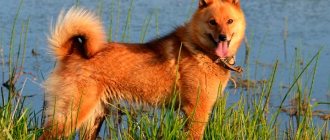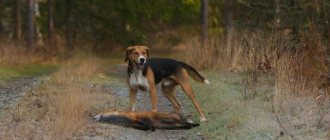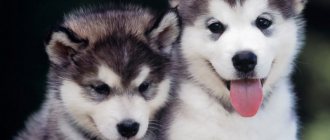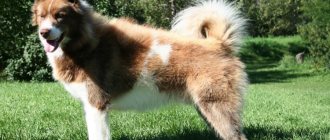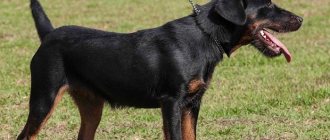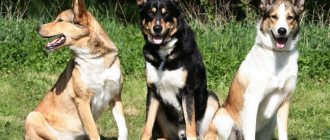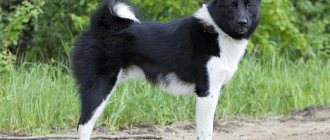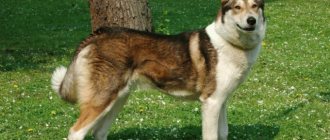Origin story
Representatives of three breeds participated in the creation of the Karelian-Finnish Laika: Olonets (derived from the name of the province), Finnish and Karelian. As a result of crossing, dogs of this breed became small in size, but their appearance was constantly changing. To make the species unchanged, breeders continued the process of inbreeding between the first individuals of this breed and Spitz dogs, which were brought from Finland. Since the results of the crossing were positive, in 1984, thanks to a vote, the two breeds were combined into a single breed - the “Finnish Spitz”.
The Karelo-Finnish Laika especially stands out among hunting
The next stumbling block was the registration of the Karelian-Finnish Laika breed at the international level. The fact is that the presence of the names of two countries in the name is not allowed according to the rules of the International Cynological Federation. Due to the fact that these provisions are unshakable, “Finnish Spitz” was approved as a name. Then this type of dog began to be bred for hunting, as well as for exhibitions. Although she has established herself more as an excellent hunter with good instincts than as a decorative dog.
Advertising:
How did the Karelian-Finnish Laika breed appear?
The first rumors about the appearance of the Karelian-Finnish Laika were identified back in the 17th century. At this time, a traveler from France, Pierre la Martiniard, while traveling in Finland, saw beautiful and unusual dogs with dark red or reddish hair, after which he wrote a detailed description about them. Such dogs were bred by ancient Suomi tribes, who needed an animal capable of hunting well.
Over time, the number of purebred representatives of this breed became smaller and smaller - this was especially observed during the war, but lovers of such animals did not let them disappear completely. In 1880, several enthusiasts began to actively breed these dogs. At the same time, the mating took place according to all standards, that is, the crossing of close relatives was not carried out, otherwise this could cause serious health problems. The puppies are also given proper care so that they can grow up to be healthy and strong dogs.
Already at the end of the 19th century, the Karelian-Finnish Laika breed began to officially exist. However, in 1897, its standards were revised, as well as its name - from that time on the animals were called Finnish Spitz.
It is important to note that the Karelian-Finnish Laika breed was actively bred in Russia (mating was carried out in several cities), because in ancient times Finland was part of the Russian Empire. After its collapse, CFLs remained in existence only in Karelia and the Leningrad region. At the beginning of the 20th century, breeders and professional hunters paid close attention to them, after which they began to actively breed the breed. Reviews from owners show that the Finnish Spitz is best distributed in its homeland, but it has gained considerable popularity in other countries, for example, in the Netherlands, the USA, and so on.
Description of the breed
There are a number of appearance standards consistent with expert opinion. The description includes the quality of the coat, color features, as well as the shape of different parts of the body.
The photo clearly shows that the Karelian-Finnish husky has a small size and cute appearance. Height and weight depend on the gender of the dog. For example, a male grows up to 50 cm, which is 5 cm higher than the height of a female. The weight of a male can reach 15 kg, respectively. this is 3 kg more than the weight of the female.
The Karelo-Finnish Laika is small in size and cute in appearance.
They also differ in their stand:
- in the male it is more inclined, and the body shape is square;
- the female has a straight back, a more elongated shape.
Even from a photo of a Karelian-Finnish husky, you can immediately determine what gender the animal is.
Origin of the breed
This type of dog was first mentioned by researcher Pierre de Martignard in 1675. One isolated tribe developed a breed of dog with a “dark red color” that so delighted the explorer.
Later, as the territory was populated, these dogs crossed with ordinary huskies, and the breed was on the verge of complete loss. That is why in the 1890s an expedition of foresters from Helsinki was formed, who went to the supposed habitats of the tribes that bred the Karelians.
Their search brought the desired result, and the foresters brought several purebred Spitz home. One of the expedition members, Hugo Rusa, bred them for about 30 years, and back in 1891, five dogs were presented at the Helsinki Exhibition. It was after this that in 1892 the first standard of the Karelian-Finnish Laika was developed and adopted, which was adjusted only once, 5 years later.
Characteristics
The first thing to note as a characteristic feature of the Finnish Spitz is its color. International standards describe it as a golden brown or bright red color. Deviation from these colors is considered defective, except for light colors. It is defined as an undesirable color. The length of the coat, its condition, or rather its density, stiffness and raisedness are also considered indisputable signs of purebredness.
Described by international standards as a golden brown or bright red color
Other standard features of the description of the Karelian-Finnish Laika are also considered:
- Head. Wedge-shaped. A pronounced transition to the muzzle. Not very thick, fully colored lips.
- Eyes. The color is light or dark brown. The shape of the eyes is oval, the inner corners are slightly lowered towards the bridge of the nose.
- Nose. The predominant color is black, but brown is also possible.
- Teeth. Strong, with white enamel, have the correct bite.
- Ears. Triangular shape, standing.
- Limbs. The muscles are dry, the joints and bones are strong. It is advisable to remove the fifth toes on the hind legs during puppyhood.
- Tail. Has the shape of a donut.
Karelian-Finnish Laika dogs are very active, and with proper training they can become a reliable assistant for a hunter.
Character
Karelian-Finnish Laika dogs are very active, and with proper training they can become a reliable assistant for a hunter. It should be noted that despite his curiosity, the dog is quite independent, and sometimes stubborn. This pet is perfect for a person with a strong character. He has a very developed sense of self-esteem, so he will treat family members exactly the same as they treat him. Reviews from owners of animals of this species make it clear that excessive emotionality should not be expected from pets. They are not inclined to bow down to their master. It is also important to note that due to their habits and character traits, they will not be able to adhere to the family daily routine.
They can get along with small children only if the baby understands that this is not a toy, but a living being with its own individual character. Otherwise, with annoying behavior, the animal may show aggression. Being a member of a hunting family, the breed does not get along well with smaller pets and views them more as prey, but there are rare exceptions. At the age of 4 years the dog becomes completely independent.
Being from a hunting family, the breed does not get along well with smaller pets
Character and education
The Karelian-Finnish Laika is an easily excitable dog. An emotional Karelian loves cleanliness and order and is attached to one place. The gaiety of her character does not prevent her from showing all the qualities of a hunter. The dog is strongly attached to the owner, tries to please him, but also knows his own worth. He builds relationships with people on reciprocity. Puppies always listen carefully to all commands, even without yet understanding who exactly is their owner.
Having matured, the pet becomes independent. This breed never “creeps” at the feet of its owner. The owner should come to terms with the independence of his four-legged friend, because this is a completely natural phenomenon. The Karelian-Finnish hunting husky does not need instructions from the owner even during the hunt - the animal relies on its own thinking.
However, if the Karelian bear husky is quite aggressive towards other dogs, then the Karelian-Finnish husky almost never gets angry and will only get into a fight when necessary.
You need to train a husky using its skills. Coercion and praise will not bring results. Try to train your pet in the form of a game, try to use the animal’s sense of smell and hearing. However, the owner must be patient and move forward in small steps. If you decide to resort to the help of a dog handler, then choose a specialist who works with hunting dogs. This breed requires individual training so that there are fewer irritants around.
Similar article: Description and characteristics of the West Siberian Laika breed
Pet care
The size of the Karelian-Finnish Laika allows it to be kept not only in a private house, but also in an apartment. Like any living creature, you will need to:
- brushing your teeth This procedure is performed from a very early age, using only special toothpaste. Also, to prevent dental disease, chew bones or special toys;
- ear cleaning. Carry out as they become dirty;
- trimming nails. This should only be done if they have not worn off on their own.
In general, the breed is easy to care for. The main points that you need to pay special attention to are walking and combing.
The size of the Karelian-Finnish Laika allows it to be kept not only in a private house, but also in an apartment.
Walk
These dogs are active, so they prefer long walks and just being in the fresh air. When starting to care for a Karelian-Finnish Husky puppy, you should keep him in an apartment or house until the first molt, which is considered the stage of growing up. After this, you can accustom him to longer walks and move him to an enclosure or kennel. The dog’s home should serve as a reliable shelter from wind and cold. At the same time, the breed has very warm fur, so don’t be afraid to take the animal out into the yard in winter.
Combing
Wool deserves special care; it is a kind of indicator of health. It is enough to bathe 2-4 times a year; the fur does not have a specific smell. Brushing is required once a week. The purpose of this procedure is to get rid of old, dead hairs to prevent matting. During the molting period, this must be done very carefully, every day. A balanced diet has a huge impact on your pet's appearance.
Wool deserves special care; it is a kind of indicator of health.
Veterinary
The Finnish Spitz has good health and excellent immunity. The average lifespan is about 11 years, but with proper care and attention, your four-legged friend can live up to 16 years. It all depends on timely vaccinations, timely detection of diseases, as well as a complete diet rich in vitamins and minerals.
Vaccinations
Vaccination is of great importance for a puppy, especially before taking the baby for a walk for the first time or introducing him to his relatives. It is important to adhere to a specific vaccination schedule:
Vaccination is of great importance for a puppy, especially before taking the baby for a walk for the first time.
- Deworming. This procedure is performed for the first time at the age of one and a half months.
- Vaccination against enteritis and plague. Do it at the age of 2 months. After 2 weeks, devaccination is carried out.
- Rabies vaccination. It is carried out after changing teeth. This vaccination is especially necessary for those who are going to take their dog hunting.
Any vaccination does not give you a 100% guarantee; it is just a preventive measure. You must take care that the puppy is not overtired, does not get hypothermic, and also avoid exposure to drafts.
Mating
Mating takes place on the 3rd heat, about 3 years of age, this period is considered the most suitable. At the time of mating, the female must have all her vaccinations and must also be dewormed. Pregnancy lasts approximately 2 months. It is almost impossible to identify it, since it is not visible from the figure, unless the appetite increases slightly. The Karelian-Finnish husky can have from 2 to 4 puppies. Photos of Karelian-Finnish Laika puppies can be seen on the Internet.
Any vaccination does not give you a 100% guarantee, it is just a preventive measure
Maintenance and care
In principle, an animal cannot live on the street. The thing is that even with thick and long fur, this does not protect the pet at all from domestic frosts. Therefore, the pet must be left at home in warmth and comfort. The only possible option is to transfer the dog to an enclosure or kennel during the warm period.
As for the maintenance in the apartment, everything is not so simple. On the one hand, the size of the dog allows this to be done, but on the other hand, an irrepressible temperament can lead to damage to furniture.
Important! When keeping in a house, care should be taken to ensure that the dog cannot escape. Because of his freedom-loving nature, he may try to do this.
How to choose?
If you decide to get a pet, you should know that you can pick up the baby at the age of 3 months. When choosing an adult, you need to take into account the peculiarities of upbringing, because there is a considerable chance that it may simply not take root with you due to its individual character traits. You can buy Karelian-Finnish Laika puppies from your own hands or from a nursery. The second option is considered better because you will be able to request the necessary documents related to the pedigree of the Karelian-Finnish Laika puppies. This point is important both for those who take an animal for hunting purposes and for those who want to participate in exhibitions.
When choosing, it is advisable to independently evaluate the appearance of the future pet, therefore, never trust photos of Karelian-Finnish husky puppies. The pet must be well-fed, have good muscular physical shape, and have thick, glossy and fluffy fur. Healthy puppies have a correct bite and clean, clear eyes. To purchase a husky for your family, it is better to give preference to females who are distinguished by a calm, affectionate and more docile character, unlike the male. Especially a lot of positive reviews are left by hunters who chose the Karelian-Finnish husky.
When choosing, it is advisable to independently evaluate the appearance of the future pet, therefore, never trust photos of Karelian-Finnish Laika puppies
Interesting Facts
The breed is distinguished by courage and bravery. An animal can rush to protect its owner, even if the threat is many times greater than the dog itself. That is why a person should adhere to one piece of advice: closely monitor your pet both while walking around the city and in nature.
The breed is simply phenomenal in health. Most ailments do not take them. However, this does not mean that trips to the veterinarian and routine checks should be ignored.
As you can understand, the Karelian-Finnish Laika is a unique breed of dog, differing not only in appearance, but also in natural qualities. The most important thing to remember is their disposition and character. If you manage to overcome them, you can raise a reliable and devoted friend.
What to feed?
Feeding a Karelian-Finnish husky puppy is required, like an adult dog, with some of the following reservations. You can start feeding your puppy at about 2 months. Until this time, babies feed on mother's milk. First they feed raw meat, preferably beef, lamb and others, except pork and chicken. After a month, non-sharp bones begin to be introduced, the main thing is that they are not too small, because they can cause injuries to the esophagus. Porridge, which must be diluted with meat broth or meat, is considered a healthy food for a Karelian-Finnish husky puppy. You can feed fermented milk products, but exclude milk and butter. Sausages, sausages, candies, all kinds of sweets, and eggs are extremely undesirable in your pet’s diet.
A separate item is dry food. You should absolutely not feed him dry food alone. Such food can be given occasionally exclusively to adult individuals, and in small quantities, since animals can overeat. Food can be used as a reward during training.
Water must be clean and constantly available. Food must be removed after 15 minutes in order to accustom the dog to the diet, which should be as follows:
- for 2-3 months – up to 4 times a day;
- 4-7 months – up to 3 times;
- from 8 months onwards – 2 times a day.
Hygiene
You don't need to bathe your dog too often. Their fur is designed in such a way that it practically does not collect dirt. In addition, the animals themselves are quite clean. Water procedures can be carried out only 2-3 times a year or in case of severe contamination. Normally, just washing your paws after a walk is enough.
But you need to comb the dog. This is usually done once a week, using a special comb. During the molting period, you will have to comb it daily. Also, special attention should be paid to the eyes and ears. The ears are inspected and cleaned once a week using hydrogen peroxide. Eyes should be washed daily with boiled water.
Upbringing
Education begins at 5 months. Training is carried out strictly, but with due respect. It should be in the form of a game involving the senses of smell and hearing. An attempt to educate with “carrot and stick” will be a failure. It's better to start with general commands and gradually move on to more difficult tasks. Learning to play is not an easy task - the owner must have a persistent and patient character for this.
If you understand that you are not suitable for the training process, then it is better to seek the help of an experienced dog handler. A well-trained dog unquestioningly obeys its owner and copes well with its responsibilities as a watchman or hunter, as well as simply a loyal and reliable friend.

